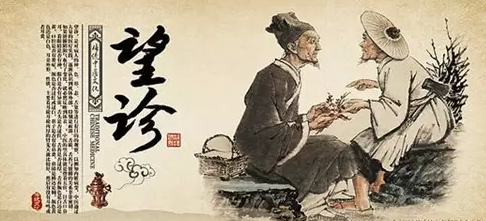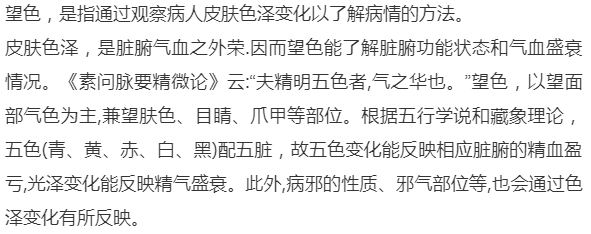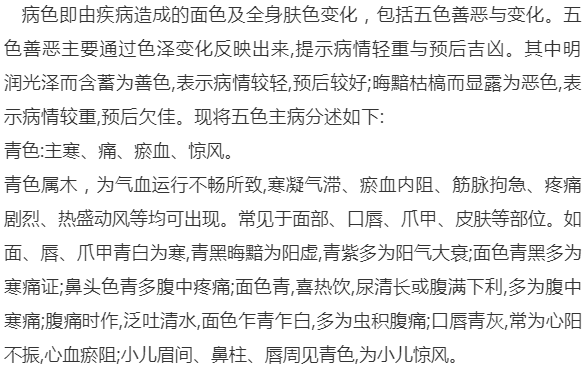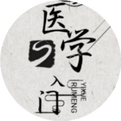 Comprehensive observation primarily involves assessing the patient’s overall appearance, including complexion and demeanor, to form a general understanding of the nature of the illness, such as cold or heat, deficiency or excess, and the severity of the condition.
Comprehensive observation primarily involves assessing the patient’s overall appearance, including complexion and demeanor, to form a general understanding of the nature of the illness, such as cold or heat, deficiency or excess, and the severity of the condition.

Observation of Shen (Spirit) Shen, in a broad sense, refers to the external manifestation of life activities in the human body, while in a narrow sense, it refers to a person’s mental awareness and cognitive activities. The observation of Shen is a method of assessing the condition by observing the overall manifestation of life activities in the body. Through this observation, one can understand the presence or absence of Zheng Qi (Vital Energy), the condition of the organs, the severity of the illness, and the prognosis. Observing Shen includes assessing the mental expression, consciousness, complexion, speech, breathing, and body posture, with particular emphasis on the expression and gaze.1Presence of Shen Also known as “having Shen,” this is often seen in patients who are clear-minded, have natural expressions, articulate speech, quick responses, abundant energy, a bright and moist complexion, lively eyes, smooth breathing, and a robust physique with well-developed muscles. This indicates a strong Zheng Qi, normal organ function, or a relatively mild condition with a good prognosis.2Deficiency of Shen Also known as “insufficient Shen,” this is often characterized by lack of energy, slow movements, little speech, sluggish thinking, a dull complexion, and lifeless eyes. This suggests that Zheng Qi has been damaged and organ function is insufficient, commonly seen in deficiency syndromes.3Loss of Shen Also known as “absence of Shen,” this is often seen in patients who are comatose, agitated, or mentally exhausted; with dull or dark eyes, slow responses, weak breathing, or even with eyes closed and mouth open, incontinence, or aimless movements. This indicates severe damage to Zheng Qi and weakened organ function, with a serious condition and poor prognosis.4False Shen Refers to a temporary appearance of improvement in critically ill patients, such as a previously lethargic patient suddenly appearing more alert, with rosy cheeks, clear speech, and increased appetite. This suggests a deterioration of the condition, with the vital essence of the organs nearing depletion and a poor prognosis. Ancient texts liken this to “returning light” or “the last flicker of a dying lamp.”Observation of Color

1Normal Color Normal color refers to the typical complexion and skin tone, which varies by ethnicity. In China, a healthy person’s complexion should be slightly yellow with a rosy hue, bright and lustrous, indicating sufficient essence, abundant Qi and blood, and normal organ function. Normal color can be divided into primary and secondary colors. Primary color refers to the inherent color that remains unchanged throughout life; secondary color refers to temporary changes in complexion due to seasonal, environmental, emotional, or physical factors, not caused by disease.2Pathological Color

Red: Indicates heat. Red belongs to fire, often resulting from internal heat, which stirs Qi and blood, filling the meridians. Commonly seen in the face, lips, tongue, and skin. There are distinctions between excess heat and deficiency heat. Externally contracted warm pathogens can cause facial redness and fever; excess heat syndrome can present with facial redness, high fever, thirst, and constipation; deficiency heat syndrome often shows rosy cheeks or flushing in the afternoon; deficiency and consumption can lead to rosy cheeks, afternoon heat, five hearts heat, and night sweats.Yellow: Indicates dampness and deficiency. Yellow fever. Yellow belongs to earth, often due to spleen dysfunction, inability to transform dampness, or insufficient Qi and blood, leading to skin malnutrition. Commonly seen in facial skin and sclera. A pale yellow and dull complexion indicates a withered yellow, belonging to spleen Qi deficiency; a puffy pale yellow face indicates yellow edema, belonging to spleen deficiency with excess dampness; a uniformly yellow complexion indicates jaundice, with bright yellow like orange peel indicating yang jaundice, a sign of damp-heat; dull yellow like smoke indicates yin jaundice, a sign of cold-damp obstruction; infants with jaundice all over are often due to fetal jaundice; infants with alternating yellow and white complexions may indicate malnutrition. A gradual improvement in yellow complexion suggests recovery of stomach Qi; if the yellow turns dry, it indicates decline of stomach Qi and a poor prognosis.White: Indicates deficiency cold and blood loss. White belongs to metal, indicating deficiency of Yang Qi, weak blood circulation, empty meridians, and insufficient nourishment of Qi and blood. Commonly seen in the face, lips, tongue, skin, nails, and around the eyes. Blood deficiency presents as pale and dull; Qi deficiency presents as pale with little luster; Yang deficiency presents as pale without luster and may be swollen; lung and spleen Qi deficiency presents as pale complexion; pale blue-white often indicates cold syndrome; postpartum pale complexion often indicates blood loss and Qi deficiency; sudden blood loss may present as pale, indicating a critical condition; if the complexion suddenly turns pale with cold sweat, it often indicates a collapse of Yang Qi.Black: Indicates kidney deficiency, water retention, and blood stasis. Black belongs to water, indicating deficiency of Yang and excess of Yin, internal water retention, stagnation of Qi and blood, and insufficient nourishment of the meridians and skin. The color can appear dark, purple-black, or blue-black, commonly seen in the face, lips, and around the eyes. A hot black complexion with purple lips may indicate kidney Yang deficiency and cold stagnation; a dry black complexion often indicates kidney Yin deficiency; gray-black around the eyes in women often indicates kidney deficiency with water retention or cold dampness; light black indicates kidney disease with cold water; black at the tip of the nose and slight swelling around the eyes often indicates internal water retention; dark skin with uneven texture indicates blood stasis; black on the forehead may indicate a reverse condition; dark rings around the mouth often indicate kidney exhaustion.Observation of ShapeObservation of shape refers to assessing the patient’s physique, including strength, body type, and abnormal manifestations to diagnose the condition.1Strength of Physique Mainly reflects the deficiency or excess of the organs and the abundance or deficiency of Qi and blood.(1)Strong physique: Refers to a robust body, characterized by large bones, broad chest, well-developed muscles, moist skin, and abundant energy with a strong appetite. This indicates solid internal organs, abundant Qi and blood, strong resistance to disease, ease of recovery from illness, and a good prognosis.(2)Weak physique: Refers to a frail body, characterized by small bones, narrow chest, thin muscles, dry skin, lack of energy, and poor appetite. This indicates weak internal organs, insufficient Qi and blood, weak resistance to disease, difficulty in recovery from illness, and a poor prognosis.2Obesity and Thinness Mainly reflects the imbalance of Yin and Yang, Qi and blood.(1)Obesity: Characterized by a round head, short and thick neck, broad shoulders, short and round chest, and a large abdomen. Obesity with pale skin and poor appetite indicates a phlegm-damp constitution with excess and weak Qi.(2)Thinness: Characterized by a long head, slender neck, narrow shoulders, flat chest, and a thin abdomen. Thinness with a pale complexion and thin muscles indicates a hot constitution with internal heat.Observation of PostureObservation of posture refers to assessing the patient’s body position and movements to diagnose the condition.1Movement and Stillness Those who prefer movement often have Yang conditions, heat conditions, or excess conditions, commonly seen lying with the face outward, moving when turning, preferring to lie on their back with legs extended, uncovering themselves, not wanting to be near heat, and being restless; those who prefer stillness often have Yin conditions, cold conditions, or deficiency conditions, commonly seen preferring to lie down, with the face inward, curled up, not wanting to move, and preferring to be covered.2Convulsions Often indicate the presence of wind. Convulsions of the limbs, facial twitching, accompanied by high fever and thirst often indicate a premonition of wind due to excess heat; accompanied by a pale yellow complexion and lethargy often indicate wind due to blood deficiency; convulsions of the limbs with upward gaze, grayish-blue color around the eyebrows and lips, occasional screaming, clenched jaws, and arched back often indicate tetanus; trembling fingers often indicate liver and kidney Yin deficiency with internal wind.3Hemiplegia Sudden collapse, loss of consciousness, numbness of one side of the body, and difficulty in movement, with facial droop, indicate a stroke.4Paralysis Joint swelling and pain, difficulty in bending and extending, heaviness, numbness, or pain often indicate bi syndrome; weakness and lack of strength in the limbs, difficulty in movement, often indicate wei syndrome.
Electronic Textbooks
| Internal Medicine | External Medicine | Pediatrics |
| Diagnostics | Obstetrics and Gynecology (8th Edition) | Infectious Diseases |
| Types of Infectious Diseases | Symptoms and Signs | Practical Skills |
| Systemic Anatomy | Regional Anatomy | Neurology |
| Emergency Management | Emergency and Disaster Medicine | Dermatology and Venereology |
Physiology (9th Edition) |
Obstetrics and Gynecology (9th Edition) | |
Basic Nursing Skills for Elderly Care Workers |
||
Guidelines for Elderly Care Practice |
 Traditional Chinese Medicine — Renwei 8th Edition
Traditional Chinese Medicine — Renwei 8th Edition

